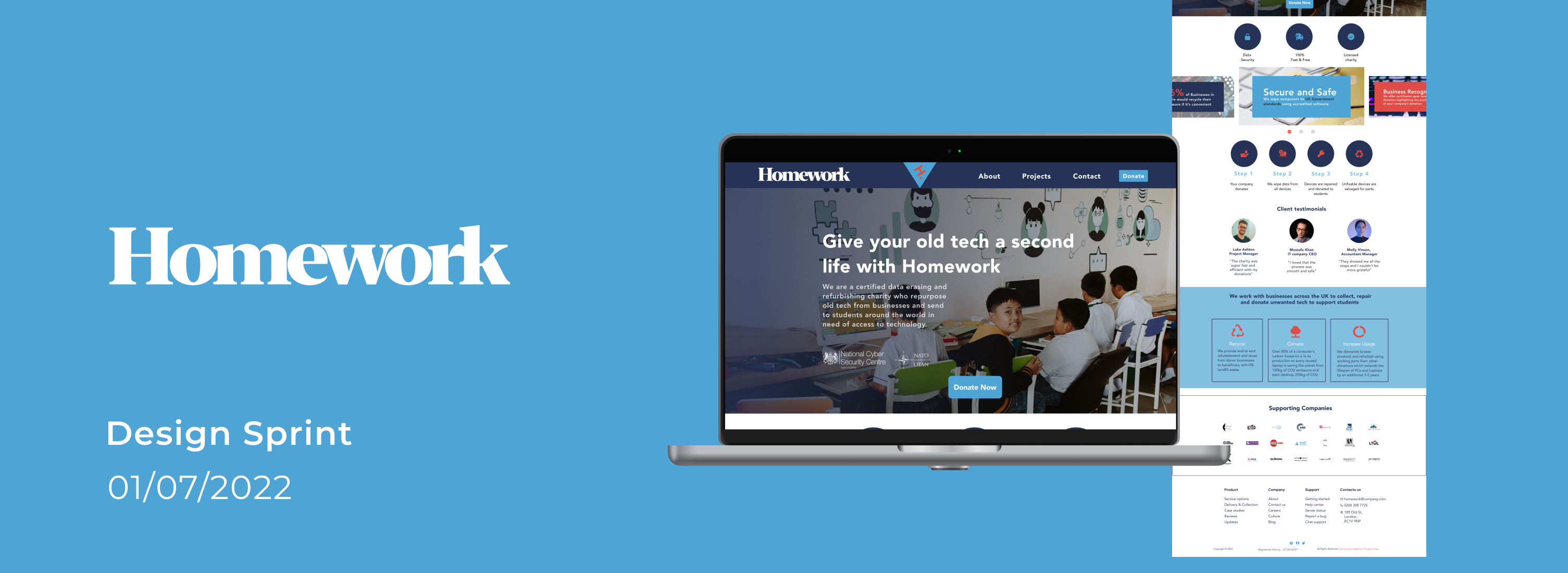
Problem
Homework is a non-profit organisation that relies on hardware donations as a means of providing individuals in need with access to technology.
- Design a Landing page that expresses the value of the homework brand.
- Design a donation experience for the Homework to encourage more businesses to recycle their hardware.
The goal
Our goal was to understand why business are throwing away old hardware.
Morover, an objective was to understand what would incentivise businesses to donate their hardware to be reused.
My role
The design sprint lasted one week, and the team was composed of 3 people: a UI designer, a Prototype stitcher and a research/ copyrighter.
My responsibility as UI designer was to develop a UI design library and implement colours and typography. Moreover, I built high-fidelity wireframes, usability testing, and a presentation deck creation.
Tools
Figma
Google slide
Project overview
Homework is a website with the purpose of encouraging businesses to donate their old hardware to Homework and increase annual donations.
Alongside designing a landing page we aimed to create an impact by providing an accessible service that facilitates software and hardware for students in need. We wanted to achieve this through more than just donation and sponsorship.

Project Challenges
The Design Sprint duration was of 3 days excluding the presentation day. Therefore, We were challenged by the limited time. We managed to finish within the deadline, by splitting roles within each other. Moreover, we consistently communicate while working outside working hours.
Problem Statement
How might simplify the donation process to allow businesses to efficiently and securely donate their old hardware?
Design Process
Secondary Research
We started with exploring the problem (swipe right to read more), where we found out what is working with the Homework competitors and what could be accomplished in the hardware industry charity.
We compared IT business like Computer Aid and Microsoft - Tech4Good and we listed things to take as a oppourtinity for our project.
Primary Research
To better understand users as hardwares donors, we conducted detailed 1-2-1 interviews with:
Business owners or Tech Managers who have valuable insights. Who work or own businesses with 15+ employees and are UK based.
Insights
We found some interesting insights from our interviewees. Mainly centred on the sustainability of their business and pain points surrounding hardwares's charity donators.
Persona
Ideation, Prioritizing, Solution design
Based on our target audience an IT business with lots of hardware to donate, we mapped out their user's experience focused on a critical moment.
From the user experience, we started to ideate and design a website with an easier way to do a donation process for a busy business manager like Jennifer.
Below are ideation process of different landing pages we chose the best design ideas and voted for the major points.

Designing the website
We took our solution sketches and started wireframing and prototyping. Here is the link of our first Prototype. Then we moved on the third day to conduct usability testing with 5 participants. The task flow starts with hitting the button "donate now" and following a step-by-step donation process through a schedule drop-off method.


Usability testing and Iterations
We tested out our website with 5 partecipants with the task: How would you donate your hardware?
We asked them these following questions in order to understand their user experience.
- If you were looking for information, where would you expect to find it?
- What are your thoughts on the design and layout?
- Were there any sections or pages that you felt were unclear or hard to understand?
- what do you think of the language used?




Outcome and Future Impact
We believe that result of our design prototype could lead to:
By onboarding businesses, Homework can help 900+ additional children on every year and save over 4000kg of hardware from going to landfill.


Key Learnings
I learned the power of collaboration within the team and this project taught me consistently communicate clearly and always expect constructive feedback.
I enjoyed the team as we all agreed on the respective roles and, we gave each other great ideas.
Next Steps
- Second round of testing with the revised prototype
- Review data to assess where users are dropping off
- Iterate, iterate, iterate
- Publish our human-centred design process online to benefit other charities and companies









